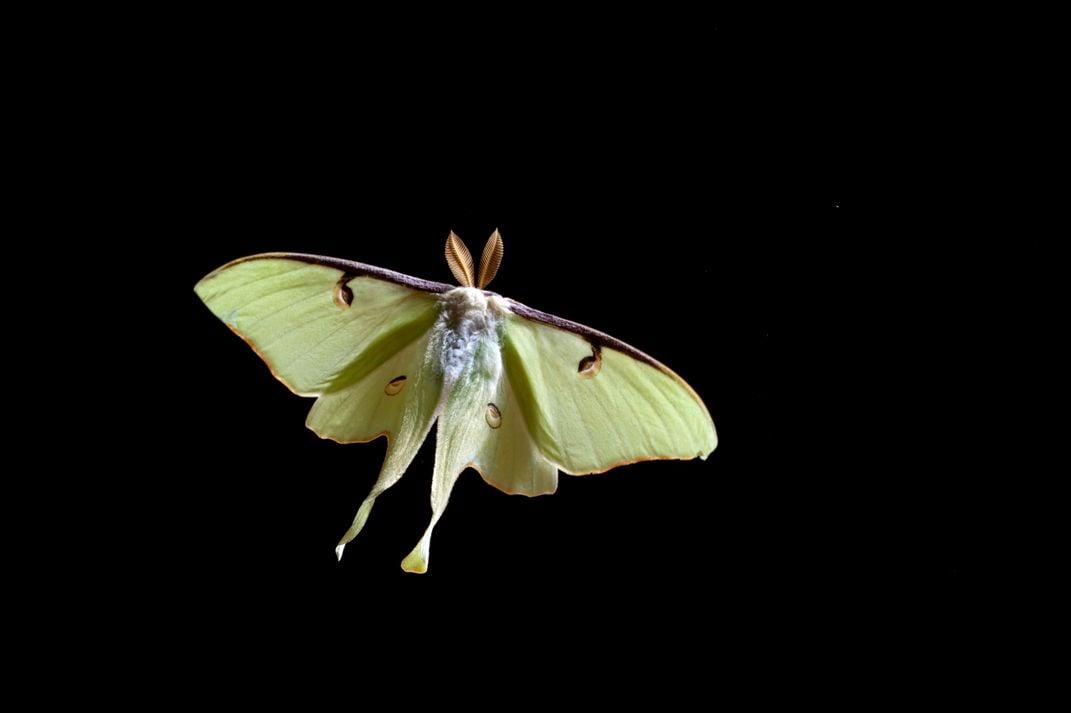This Echolocating Dormouse Could Reveal the Origins of One of Nature’s Coolest Superpowers
Mice, moths and even humans use clicks and echoes to “see” the world around them
/https://tf-cmsv2-smithsonianmag-media.s3.amazonaws.com/filer/f2/88/f288a843-41a2-4273-ac8a-c04f1f658a16/typhlomys_cinereus_zookeys-164-041-g004.jpg)
When the sun goes down on the forests of Vietnam, a small, secretive rodent emerges from the darkness and begins zipping across tree branches in search of fruit and seeds. Typhlomys, also known as the soft-furred tree mouse or Chinese pygmy dormouse, is around three inches long and sports a white-tufted tail longer than its body. But it darts so fast that, to the human eye, it appears as little more than a nocturnal blur.
That’s especially impressive, because Typhlomys is almost completely blind.
When scientists looked at Typhlomys eyeballs under a microscope, they quickly learned that its visual organs are a total mess. Irregular retinal folds “destroy continuity of image projection,” researchers wrote, while a reduced space between the lens and the retina mucks up the animal’s ability to focus. They also have a reduced number of image-receiving ganglion cells, which are usually an indicator of perception. The arboreal rodents seem capable of determining the difference between light and dark, but little else.
So how does Typhlomys avoid falling to its death or running straight into the jaws of a predator? According to a paper published in Integrative Zoology last December, this long-tailed furball has a trick up its sleeve: It emits ultrasonic chirps, and then navigates its environment based on the echoes that bounce back. If that sounds a lot like another nocturnal mammal, you’re right: Some scientists believe that Typhlomys might be a sort of “transitional animal” that could be the key to understanding bat evolution.
That’s because Typhlomys echolocates, a biological trick that has long been thought to exist solely in bats, cetaceans, and Marvel’s Daredevil. (Some shrews were once also thought to echolocate, but newer research seems to debunk this.) That is, until scientists in Russia were able to observe a pair of these Vietnamese dormice in captivity and record their ultrasonic squeaks.
“The structure of its calls is surprisingly similar to the frequency-modulated calls of bats,” says Aleksandra Panyutina, a functional morphologist at Severtsov Institute in Moscow and lead author of the paper describing the dormouse’s echolocation.
The difference, says Panyutina, is that the Typhlomys’s calls are incredibly faint. They escape both the human ear and devices called “bat detectors” scientists usually employ to listen in on bat chatter. But this also makes sense, she says, because even though Typhlomys is fast “as a thunderbolt,” it’s still much slower than a bat flying through the air, and the objects it must navigate are much closer.

The discovery of a superpower-ed rodent is exciting for many reasons. For starters, it’s a first for the Rodent Order. Second, there are clearly plenty of rodents who get along just fine without the aid of ultrasonic clicks—which begs the question of what would lead Typhlomys down this evolutionary path. But none of these are as tantalizing as what an echolocating rodent means for our understanding of bat evolution.
You see, scientists have long debated when exactly echolocation evolved. The existence of echolocation-less fruit bats has always seemed to suggest that the ability to echolocate was acquired after some bats took to the skies. Yet other scientists argue that the opposite might also have been possible—that small, bat-like creatures used echolocation as they hopped and even glided through the canopy, and only later acquired full-fledged flight.
However, there was a big problem with this “echolocation-first theory”: We had no record of any such transitional animal ever existing, either living or fossil. “Nobody could even imagine such a critter,” says Panyutina, “until our discovery on Typhlomys.”
Of course, the debate is far from concluded. In fact, a recent study of bat ear bones suggests that fruit bats never had the ability to echolocate, which would be a vote in favor of the flight-first theory. And another study found that some species of fruit bat can produce echolocation clicks with their wings, which is just totally batty when you consider that every other echolocating animal seems to emit those sounds from its mouth.

Or maybe it isn’t that batty after all. We’re living in a golden age of echolocation research; more than 100 studies with the word “echolocation” in the title have been published since the beginning of last year alone. And as research into Typhlomys shows, we still have much to learn about the origins and nature of this remarkable ability. Is it such a stretch to think there are other methods of echolocation that researchers haven’t yet imagined?
For instance, a study published last fall in PLOS Biology explored the reason that big brown bats waggle their heads like puppy dogs and curl the tips of their ears down. We’re talking about movements that take place over the course of milliseconds and on the scale of millimeters, says Melville Wohlgemuth, a neuroscientist at Johns Hopkins University and lead author of the head waggle study.
The movements aren’t just cute: Each subtle shift in the bat’s head or ear position allows it to narrow its field of “view,” sort of like when we squint our eyes or put a cupped hand up to an ear. “By having a wider acoustic view, they make sure they can still receive echoes from the target even if it moves erratically in front of them,” says Wohlgemuth. “And that’s something insects do frequently. When they detect that there’s a bat about to catch them, they sort of power dive.”
Without the fancy, high-resolution cameras that have become available in recent years, we’d never have been able to observe bat behavior in such detail. And that’s just one example of the complexities of classic echolocation. There are even stranger forms of this superpower out there—sometimes arising as a countermeasure to bat echolocation.
There are moths, for example, that can hear when a bat is closing in. But other moth species don’t have ears, so they have to rely on other ways to thwart their enemies. The brilliantly hued luna moth has evolved a swirly tail that generates a persistent weak echo signal of its own—a signal that disrupts the bat’s precision and causes it to miss. Tiger moths, on the other hand, produce ultrasonic clicks as a way to make bats more aware of their presence. These moths aren’t ringing the dinner bell: they're downright toxic, and their clicks are meant to advertise that fact. (“Don’t eat me, bro. You won’t like how I taste.”)
There are also moths that can fight fire with fire, so to speak—like the sherbet-colored Bertholdia trigona, a species native to the Arizona desert. “When approached by the bats, the moths produced their own ultrasonic clicking sounds at a rate of 4,500 times per second, blanketing the surrounding environment and cloaking themselves from sonar detection,” wrote my Smithsonian colleague Joseph Stromberg in 2013.
Of course, dolphins, whales and porpoises have tricks of the own, and echolocation is a bit different underwater. Sound waves travel much farther down where it’s wetter, which gives marine mammals the added bonus of long-distance communication. But that doesn’t mean they suffer from farsightedness: In fact, dolphins can use their sonar to tell the difference between objects as small as a kernel of corn and a BB pellet.
…
For his part, Wohlgemuth hopes we can use insights into bat biology to better understand how our own brains process sound. But there may be an even more direct line to draw here: Research has shown that "a small number of blind people"—that is, humans—can train themselves to navigate through complicated environments using echolocation.
One of these people is Daniel Kish, who has been blind since he was 13 months old, and whose adeptness with echolocation has earned him the nickname "Batman." Just like most bats, echolocating humans use clacks of the tongue or sometimes the reverberations from their cane in order to visualize the world around them. One study found that when the human brain goes to process these click-echoes, it uses regions typically associated with vision, as opposed to hearing.
Researchers like Panyutina, meanwhile, are wondering just how many more species might be out there quietly clicking away. In fact, Typhlomys has a cousin, the Malabar spiny dormouse, that is also known for its poor eyesight and nocturnal, tree-climbing prowess. The spiny dormouse has considerably larger eyes however, so Panyutina thinks it could represent a more primitive step in the direction toward the total echolocation exhibited by Typhlomys.
If we only just discovered echolocation in a dormouse, who knows what secrets other critters might be able to teach us about predator-prey interactions, co-evolution or even the inner workings of the human brain? All we have to do, it seems, is find new ways to listen.